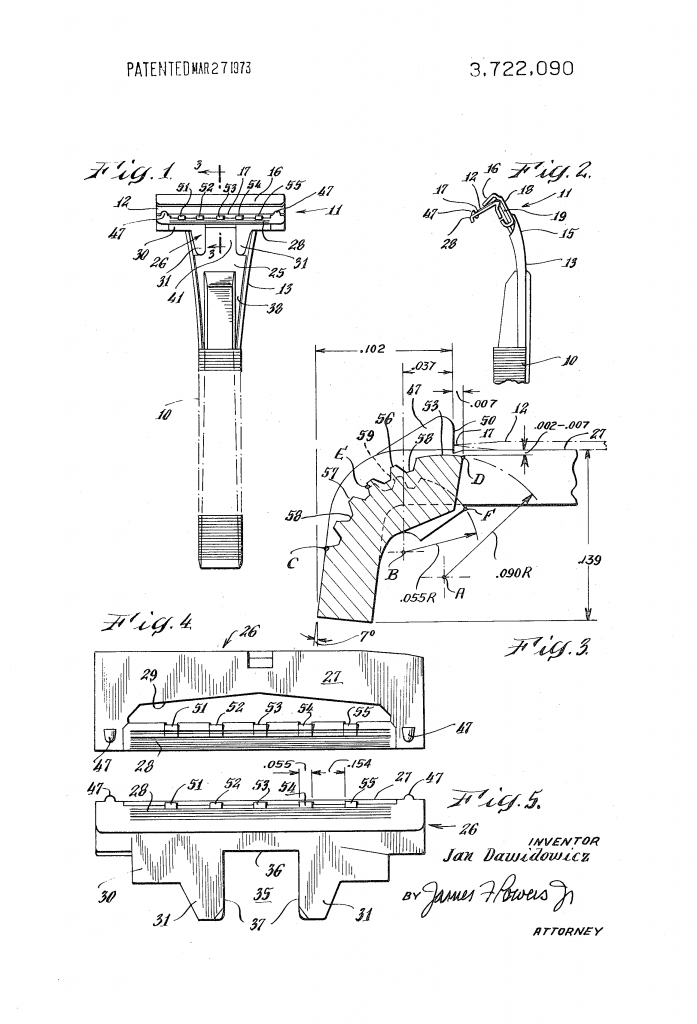A guard bar for a safety razor don’t sound like something you could file a patent for in 1971. After all, all safety razors – well, almost all – have had a guard since the original Kampfe. You could argue that the concept of a guard was inherent to the idea of a safety razor, from Jean Jacques Perret and until today. So… since Jan Dawidowicz did in fact get a patent for a guard bar for safety razors in 1973, it must have been a special guard bar. Special and non-obvious. And Even in hindsight I would say the later is correct.
Most patents seems to revolve around solving a problem, imaginary or otherwise.1 So let us see what problem Jan was wanting to solve.
It is known to provide a continuous guard bar surface extending parallel to the cutting edge of a blade and positioned below and outwardly from the cutting edge. Guard bars of this type are shown at least in U.S. Pat. Nos. 2,911,713 and 3,171,198. Such guard bar surfaces act to stretch and smooth the skin prior to the skin coming in contact with the cutting edge of the blade. Further, guard bars of this sort provide a predetermined cutting angle for the blade, and also limit the amount of skin which may enter between the guard bar and the cutting edge of the blade. However, even with a continuous guard bar individuals having skin imperfections such as acne may be susceptible to nicks and cuts.
From US patent 3,722,090
So, in short, Jan felt that the current state of the art meant that people with acne and other bumps on their cheek would run the risk of cutting or nicking themselves. And honestly, he wasn’t wrong. One reason I always take the time to wash and prep before shaving is to make sure blackheads and zits don’t turn into nicks and weepers. A little effort before the shave saves a lot of burn from the aftershave.
As an aside, the two patents referred to are a 1959 patent for an injector and a 1961 patent for a double sided injector.2 Jan keeps mentioning other patent numbers in his patent text, so it is clear he was not ignorant of the state of the art when he came up with his idea.

The invention – the patentable bit at least – sounds simple. It consists, as far as I can tell, by the addition of a plurality3 of spaced ridges4 just next to the cutting edge of the blade.
These ridges on the guard bar should, at least according to the patent text, smooth and stretch the skin in such a way that a minimum amount of skin would enter between the guard and the blade.
The patent drawing shows an injector, which is not surprising seeing as how the patent assignee was Warner Lambert Co. They acquired Schick razors from Eversharp in 1970. It makes sense that a razor related patent would apply to a razor they owned. Even so, the patent text point out that the invention can be used with any razor that has one or more cutting edges. There is no reason why your next DE shouldn’t have Jan’s special guard bar. But then again, is there a reason for it to be there?
Does it work? Perhaps. But we don’t see a lot of razors for sale today that have a plurality of ridges. This would imply that the cost of adding them don’t give enough benefit to be worth it. After all, the problem can be fixed with decent prep and tugging on the skin. This feels like a solution in search of a problem. Something Jan’s invention has in common with most patents I look at.
The full patent can be read at Google Patents.
Footnotes
- Most often imaginary or insignificant.
- I must take a good look at that one soon.
- You could even say a multitude.
- Labelled 51-55 on the drawing, most easily seen in Figure 4.

Pingback: Guard bar for safety razors - Razors n Blades the shave that saves